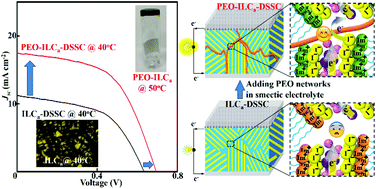Interconnection of smectic domains by polyethylene oxide networks for long-range conducting channels towards efficient and thermally stable dye-sensitized solar cells†
Abstract
The development of an efficient electrolyte that combines fast charge transport and high stability for advanced energy devices remains a huge challenge because these two qualities are traded off during the normal design process. Nanostructured liquid crystals have shown potential as efficient charge transport media. However, the reported liquid crystal electrolytes showed limited performance in energy devices probably due to the charge transport barrier at the domain interfaces. Herein, a novel approach was proposed to construct self-assembled long-range charge transport channels in liquid crystal electrolytes by interconnecting the liquid crystal domains via flexible polymer networks. A liquid crystal gel electrolyte was prepared by solidifying a smectic electrolyte using polyethylene oxide (PEO) networks, and applied to improve the performance of the dye-sensitized solar cells (DSSCs). In the gel electrolyte, the smectic assembly formed lamellar nanostructures for charge transport at the intra-domains, while the PEO networks aggregated amorphously at the domain interfaces, acting as bridges to interconnect the smectic domains for charge transport over the inter-domains. Based on the coordination of the smectic assembly and PEO aggregation, the charge transport in the liquid crystal gel electrolyte was greatly improved despite a higher viscosity. Conversely, the photovoltaic efficiency of the DSSC prepared from the liquid crystal gel electrolyte was about two times enhanced, with a champion efficiency of 7.2%, compared with that from the smectic electrolyte without PEO. The liquid crystal gel-based DSSC showed superior stable performance within a wide temperature range from 30 to 70 °C, and stored after 5000 h. Our work here provides a novel and convenient approach to break the trade-off for high-performance electrolytes towards efficient and stable energy devices.



 Please wait while we load your content...
Please wait while we load your content...